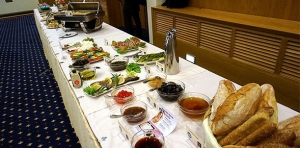ABOUT US
XpatAthens
How To Celebrate A Greek Christmas
Greek Christmas celebrations last for 13 days, from Christmas Eve until Epiphany, January 6 - the day that the Magi arrived in Bethlehem - bringing gifts to the Christ child. Many Greek Orthodox residents fast during the four weeks of advent, so elaborate preparations are made for the Christmas feast. Greek culture has not traditionally inclulded elaborate decorations, although in recent years we see more and more lights and seasonal decorations. Athens now also boasts one of the largest Christmas trees in Europe and its lighting is an annual tradition. On the islands, traditional fisherman communities and their families still decorate a small ship instead of a tree, symbolizing their ties to the sea. Greeks have traditionally given simple gifts, and usually on Epiphany, instead of on Christmas, symbolizing the gifts of the magi.
Greek Holiday Baking
Baking is an important part of Greek cooking for Christmas. Bread is the most important of the Greek holiday foods. Historically, flour and yeast were scarce and expensive and thus saved for special meals. Traditional items, such as Christmas bread or stravropsomo, a fruit-filled loaf, decorated on top with the sign of the cross and Chistopsomto or “Christ’s Bread”, a leavened bread made of flour, sesame seeds, and spices, such as anise, orange, cloves, and cinnamon accompanied by dried figs, are eaten on Christmas Eve.
Other traditional Greek Christmas sweets include diples - fried dough strips dripped with honey, kourabiedes - holiday butter cookies, kataifi - phyllo-wrapped confections made from cinnamon and sugar and drizzled with honey, melomacrona - popular honey cakes, and the ever-popular sweet pastry, baklava.
Christ’s Bread
Greek Christmas celebrations begin on Christmas Eve with the breaking of Chistopsomto. The loaf is set on the table and surrounded with nuts, dried fruit, and other treats. The head of the household blesses the loaf and each person gets a slice, drizzled with honey. Before anyone eats the bread, the group lifts the table slightly three times, signifying the Christian trinity. In some regions of Greece, an olive branch is inserted into the bread on end, like a tree, symbolizing peace. Other regions leave the first slice of the loaf outside the front door for the poor.
The Christmas Feast
The traditional Christmas Day feast is centered about either a turkey or goose, stuffed with a mixture of rice, pine nuts, chestnuts, cinnamon, cloves, and allspice. Roast pork with cabbage or cauliflower is another popular holiday choice, one that dates back to the early Christian era. Family is important in Greek culture and the Christmas meal is usually a large one, often featuring two or more main dishes. Side dishes, such as roast potatoes and grilled vegetables often accompany the meal.
Greek Holiday Food Symbols
Pomegranates, the bright red fruits indigenous to the Mediterranean, have been a symbol of prosperity since the days of the ancient Greeks. It is commonly used during the Christmas season, both as decoration and as food. Basil is also a Greek Christmas symbol. A sprig is traditionally wrapped around a cross and sprinkled with holy water each day during the season.
Regional Customs
Different regions throughout Greece have their own variations on holiday traditions. One such charming custom comes from the Greek region of Epirus; there, the Christmas bread is decorated with dough shapes representative of the family’s occupation, a shoe for a cobbler or a plow for a farmer. Additional small loaves, called kouloures, are made in celebration for the animals – donkeys, sheep, and goats – in this traditional rural area, and are broken up and given to the beasts as a symbol of good health for the coming year. Other figure eight shaped loaves, koliantines, are baked for the children, also as a symbol of health.
All in all, celebrating a Greek Christmas is about sharing the joy of the season with family and friends! Here are a some ideas on how to give your Christmas a Greek touch.
- Take the children to see Santa Claus (more commonly referred to in Greece as Saint Nicholas), who can often be found outside shopping areas giving treats to children.
- Expect neighborhood children to sing "kalanda" (Christmas carols) on Christmas Eve and offer their good wishes to you. Have dried figs, walnuts, almonds and - most important - coins on hand to offer the youngsters who come to your house.
- Prepare a holiday feast for Christmas Eve. Serve traditional foods and wine with baklava for dessert.
- Bake loaves of "Christopsomo" (Christ bread), a sweet bread formed into shapes of your choice. You can also decorate the loaves with symbols that reflect your family's trade. Serve the bread with dried figs.
- Display a wooden bowl with a piece of dangling wire holding a sprig of fresh basil wrapped around a wooden cross; this is the Greek symbol for Christmas. Keep fresh water in the bowl to keep the basil alive.
- Immerse the basil and cross in holy water once a day and sprinkle drops in every room of your house to keep the 'bad spirits' or 'killantzarin' away. These spirits are known to slide down the chimney between Christmas and Epiphany (January 6) and play mischievous pranks on your family.
- Remind your children to hang their socks over the fireplace, where small gifts will appear.
- Serve vasilopita, or Christmas cake, on December 31. Bake a florin (gold coin) into the cake. Whoever finds the coin in his or her piece of cake will have good luck in the coming year.
- Exchange gifts on January 1, which is St. Basil's Day. Also perform a renewal ceremony on this day by replacing all the water in your jugs with St. Basil holy water.
Athens To London / London To Athens By Train
You can reach Greece from London either by train to Italy for the ferry to Patras, or by train all the way to Athens across eastern Europe via Vienna and Budapest. Here are the main options:
Option 1, by train to Italy then cruise ferry to Greece...
This is the quickest, cheapest and most comfortable way from London to Greece without flying. It's shown in red on the route map below. It's a wonderful trip and a great alternative to a flight, taking just 48 hours from St Pancras station to stepping ashore in Greece. Take Eurostar from London to Paris, the overnight sleeper from Paris to Bologna, then an air-conditioned train to Bari in southern Italy. Modern cruise ferries sail overnight from Bari to Patras in Greece, for the train to Athens. Why not stop off to see a little of Italy on the way?
Option 2, by train all the way to Athens...
The overland route from London to Greece takes you via Paris, Munich, Vienna, Budapest & Bucharest to Thessaloniki, Larissa & Athens. This route is shown in dark blue on the route map below. Alternatively, you can travel via Brussels & Cologne, and/or via Belgrade - these alternative routes are shown in light blue on the map below. The complete journey from London to Athens takes 3 nights, with safe & comfortable sleeping-cars available for each of the overnight sections. It's an exciting journey with some wonderful scenery on the way, via Transylvania and the mountains of Greece. Feel free to stop off if you like, too.
Option 3, by train to Venice then by cruise ferry...
This is a simpler but longer variation of option 1. You can take the train from London to Venice and a cruise ferry from Venice to Patras in Greece for the train to Athens. This shows you Venice on the way, and it's a simpler train journey as there's a direct sleeper train from Paris to Venice. Ships from Venice to Patras sail either daily or several times each week, depending on the season.
For further information and details please visit: Seat61.com
5 Of The Best Campsites In Greece
Here's a small list of some of the best campsites in Greece.
1. Enjoy Lichnos Camping
@enjoy_lichnos_bay_village_
Parga is one of the most picturesque villages on the west coast. Its Venetian-influenced buildings huddle together on the hillside, with whitewashed alleyways and bougainvillea tumbling down to the bay. A few miles south, you’ll find Enjoy Lichnos Camping, a welcoming haven set within an olive grove. Pitches are close to the beach in an RV-free meadow. Hire a catamaran or kayak, explore the sea caves or just chill in the friendly alfresco bar. Just half an hour away are the creepy, mythic ruins of the 2,500-year-old Necromantion, the gateway to the underworld.
2. Poros Beach Camping 
@porosbeach
A snake of road wheels by shady groves, dozing horses, and somnolent villages on its way down to Poros’s fine-pebbled beach. You can relax in the shade of the site’s stylish restaurant, head to the charming little port of Vasiliki for water-side dining, or just flop on the beach, watching the blue horizon compete with the serenity of the turquoise sea.
3. Tartaruga Camping
@katemarshallevansartoutdoors
Tartaruga offers one of the most dramatic views of any campsite in Greece; stare down at the epiphany-inducing sea from the giddy heights of its alfresco restaurant, unblemished but for a deserted island and the occasional puttering of a fisherman’s boat. As if to confirm its pedigree, loggerhead turtles have chosen the turquoise waters beside the site as a safe place to mate.
Lounge in the shadow of pines or visit the beach. You’re in the middle of nowhere – but the sense of dramatic escape is much the better for it.
4. Camping Areti 
@xeaionescu
Areti sits on acres of eucalyptus and exotic flora. Its tranquil taverna is delightful, as are the many amenities, including a playground and tennis courts. There are hidden recesses, for cheeky romance, and inviting lookout points, for watching the sun go down. You can camp near the sea beside one of two beaches, dramatically screened by gnarled olive trees. On a clear morning, you can see the distant peak of Mount Olympus. For lunch, head to one of the tavernas in Neo Marmaras, an unpretentious market town.
5. Camping Antiparos
@vskrou
Antiparos is an intimate island just over the water from its larger sibling, Paros. Its harbor feels like a composite of everything Greek, with wrinkled fishermen, ripe fruit spilling from colorful crates, and an azure sky pure enough to melt the heart. No less enchanting is Camping Antiparos, on a rugged headland beside the sea. You can pitch under a tangled canopy of cedars or find a secret spot in the site’s bamboo field. The restaurant is a honey pot of homemade indulgence.
Russia Considering To Ease Embargo On Greek Products
The Russian government is currently considering to loosen its embargo imposed upon European Union (EU) agricultural products from several member-states, among which is Greece, by allowing products to be processed within the country, President Vladimir Putin‘s spokesman Dmitry Peskov said earlier today.
In an interview to newspaper “Izvestia,” Peskov highlighted that under the rules of the World Trade Organization (WTO), Moscow is not entitled to completely exempt an EU member-state from sanctions against the bloc.
“There are quite straightforward rules at the World Trade Organization, and Russia, as a WTO member, cannot choose. We cannot impose sanctions against EU member-states and selectively lift sanctions on one of the countries,” the Kremlin representative said. However, as he added, the direct deliveries of agricultural products can be substituted by “imports of raw materials with an investment in Russian-based food processing facilities.”
It should be noted that earlier on February, the Russian President has declared that Moscow would be able to cooperate with Hungarian agriculture despite Western sanctions and Russian counter sanctions.
To read more, please visit greekreporter.com
By Aggelos Skordas
25% Increase In Online Purchases
Infobank Hellastat has reported a significant growth in recent years in the domestic online market, mainly due to lower prices compared to conventional stores, and Greek consumers’ gradual familiarization with technology.
An ELTRUN survey cited in Infobank Hellastat’s study, shows that in 2013 the sales in Greek and foreign e-shops by Greek consumers amounted to 3.2 billion euros, showing a 25% increase compared to the previous year while the market has grown even further in 2014, as the number of products bought by Greek consumers online increase by 10% throughout the year.
Moreover, the frequency of on-line purchases has also increased from one per month in 2013, to three per two months in 2014. On-line consumers amounted to about 2.2 million in 2013, while in 2012 their number stood at 1.9 million, representing 35% of Internet users, compared with 70% in Western Europe. Furthermore, 60%-65% of purchases are made on Greek websites while 90% of European consumers prefer national websites for their purchases.
To read more, please visit greekreporter.com
By Ioanna Zikakou
Greek SYMPOSSIO Organized In 6 Italian Cities
The gastronomical journey that took place in six Italian cities — Milan, Bologna, Pesaro, Rome, Florence and Turin — was possible thanks to the cooperation of tour operator Eden Viaggi and Greek hotel chain Aldemar Hotels. This year’s event was dedicated to Greek cuisine and it took place from February 16 to 26, with the participation of Italian journalists, tour operators and bloggers who work in the field of travel and tourism.
Under the valuable guidance well-known Aldemar Hotels chefs, journalists and tour operators got involved in preparing Greek dishes inspired by the four seasons. Sympossio 2015 opted to present the following Greek dishes: trachanas with mushrooms and cheese for winter, salad with beetroot and baked feta for spring, sea bass a la spetsiota for summer and loukoumades with honey, nuts and ice cream for autumn.
“Our aim is to promote Greek gastronomy as part of our tourist wealth, with the direct participation of journalists from specialized magazines, tourism agencies owners and managers and young bloggers, who promote our country via the Internet,” said Kyriaki Boulasidou, head of the Greek National Tourism Organization office in Italy.
To read more, please visit greekreporter.com
By Ioanna Zikakou
Athens Law School Wins Int’l Competition
The Athens Law School Team has won the third edition of the European Moot Court Competition in English on the European Convention on Human Rights, after beating a team from the University of Essex (United Kingdom) in the final round.
Moreover, the Best Orator prize was awarded to Myrto Stavridi, also from the National and Kapodistrian University of Athens and the Best Respondent Written Submission prize was given to the teams from the University of Essex (United Kingdom) and from the Democritus University of Thrace (Greece).
The Moot Court Competition offers law students practical experience on the European Convention on Human Rights and its implementation. The winning team is awarded a traineeship at the Court. The competition is organised by the European Law Students Association (ELSA) with the support of the Council of Europe.
For more information, please visit greeknewsagenda.gr
Greek FinMin Varoufakis’ Interview In Charlie Hebdo
The latest issue of French magazine Charlie Hebdo hosts an interview with Greek Finance Minister Yanis Varoufakis. The issue was released on Wednesday, February 25, and, according to new editor Gerard Biard, pays tribute to extremism, in the shadow of the murderous attacks in Copenhagen on February 14 and 15.
The magazine cover features a sketch of Marine Le Pen, Nicolas Sarkozy, the Pope and a jihadist with a Kalashnikov chasing a dog that has a Charlie Hebdo issue in its mouth.
In his interview, Varoufakis said that racists and nationalists will be the only ones to benefit if European leaders shoot down Greece’s new anti-austerity government. “This is what I tell my counterparts: if you think it is in your interest to shoot down progressive governments like ours, just a few days after our election, then you should fear the worst,” he said.
To read more, please visit greekreporter.com
By Ioanna Zikakou
Record Greek Participation In Fruit Logistica
A record number of Greek participants was documented at the international fruit and vegetable fair “Fruit Logistica 2015” that took place in Berlin. Based on the number of exhibitors, Greece was in 15th place, according to the German-Hellenic Chamber of Commerce.
A total of 45 participants represented Greece in the international fair, ten more than in 2014. The list of Greek participants included rural cooperatives, fresh fruit and vegetable businesses, as well as technical systems, equipment and packaging companies. The participants were divided in three group kiosks that reinforced Greece’s image and promotion of Greek products abroad.
Twelve Greek companies were represented at the Enterprise Greece Investment & Trade Promotion kiosk, five companies at the Great Trade Exhibitions & Export Consulting kiosk and three companies at the Economotechniki kiosk, which organized a special event under the Freshly program for the promotion of Greek fresh fruit.
To read more, please visit greekreporter.com
By Ioanna Zikakou
Greeks In Germany Organize Rally To Support Greek Gov’t
Greeks in Germany are calling on all the Diaspora members and European citizens to support the Greek government’s struggle against international creditors.
Using the slogan “Europe with Democracy and Solidarity” they have organized a campaign through social media, in support of their homeland.
They urged citizens of Italy, Spain, Portugal, as well as other European countries to participate in the rally to show support towards the Greek government in this time of need.
To read more, please visit greekreporter.com
By Ioanna Zikakou










